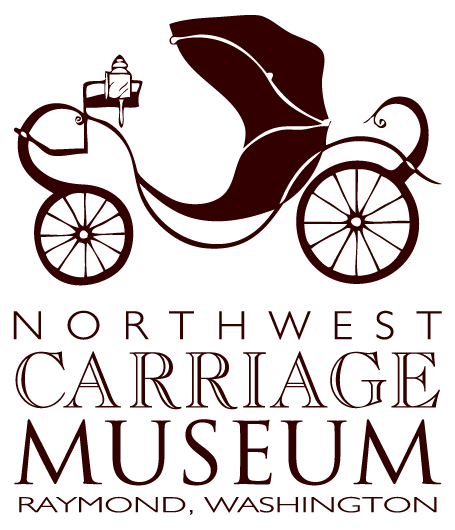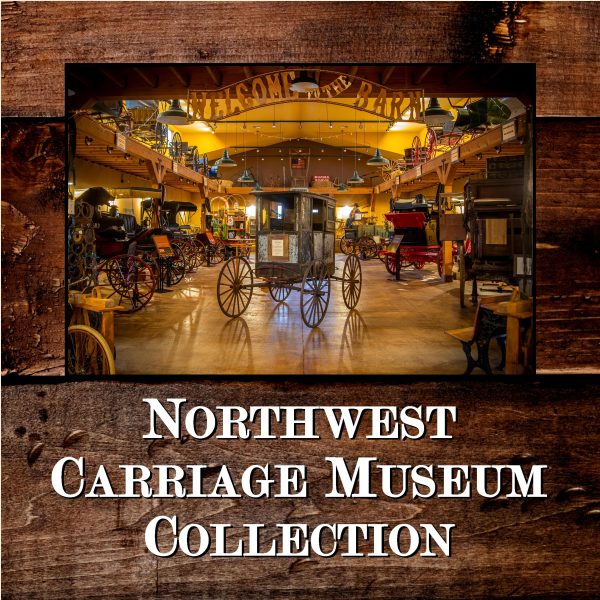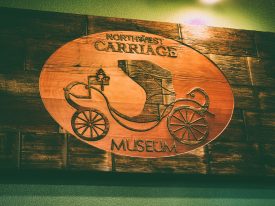 Does anyone remember the old redwood water tower out on the South Fork of the Willapa River? We don’t have the tower itself, but we do have two beautiful Northwest Carriage Museum signs made from the original water tower redwood hanging above our front doors. These incredible pieces of artwork were designed and created by our good friend and wood carver, Jeffro Uitto, out in Tokeland. Jeffro is a woodworking extraordinaire and a man of many talents, you should see the magic he works with driftwood! His work is known throughout the world. Come take a look!
Does anyone remember the old redwood water tower out on the South Fork of the Willapa River? We don’t have the tower itself, but we do have two beautiful Northwest Carriage Museum signs made from the original water tower redwood hanging above our front doors. These incredible pieces of artwork were designed and created by our good friend and wood carver, Jeffro Uitto, out in Tokeland. Jeffro is a woodworking extraordinaire and a man of many talents, you should see the magic he works with driftwood! His work is known throughout the world. Come take a look!
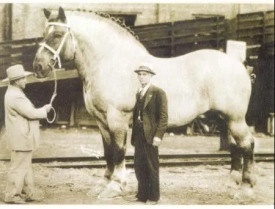
This picture is said to show Mammoth, the Guinness Record holder for largest horse. While the photo is not confirmed and may be too new to be the authentic record-holder, it certainly depicts an outrageously large horse as a reference point for Mammoth’s impressive size!
Did you know the world’s biggest horse lived in the 19th century? Originally named Samson, Mammoth was a Shire horse gelding born in 1846 at Bedfordshire, England. Towering at 21 hands and 2 ½ inches (about 86 1/4inches), the horse was aptly renamed Mammoth, and he weighed a hefty 3,360lbs! By comparison, many cars don’t even weigh that much: For instance, a 2022 Honda Civic weighs between 2,877 and 3,077 pounds, depending on the model.
Fun fact… the average 1000 lb horse drops about 31 lbs of manure and 2.4 gallons of urine per day. I would not have wanted to be in charge of mucking Mammoth’s stall!
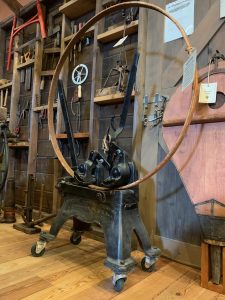 A tire shrinker (originally spelled “tyre”) was an important tool in the blacksmith/wheelwright shop back in the day of horse drawn transportation. Also known as an “upsetter,” the tire shrinker was used to resize the metal band that went around the wooden spoked wheels of buggies, wagons and carriages. When the hub and/or spokes dried out due to age or weather, the metal band, called a tire or tyre, became loose. The tire would be removed from the wheel, heated, and put into this machine. It would then be “upset” or squeezed leaving a small bulge which would be hammered flat and trimmed on the edges. This process created a tire which was slightly smaller in circumference. At this point, the tire would be reinstalled on the wheel. Our tire shrinker was once part of a blacksmith shop in Oklahoma and is a remarkable piece of American history.
A tire shrinker (originally spelled “tyre”) was an important tool in the blacksmith/wheelwright shop back in the day of horse drawn transportation. Also known as an “upsetter,” the tire shrinker was used to resize the metal band that went around the wooden spoked wheels of buggies, wagons and carriages. When the hub and/or spokes dried out due to age or weather, the metal band, called a tire or tyre, became loose. The tire would be removed from the wheel, heated, and put into this machine. It would then be “upset” or squeezed leaving a small bulge which would be hammered flat and trimmed on the edges. This process created a tire which was slightly smaller in circumference. At this point, the tire would be reinstalled on the wheel. Our tire shrinker was once part of a blacksmith shop in Oklahoma and is a remarkable piece of American history.
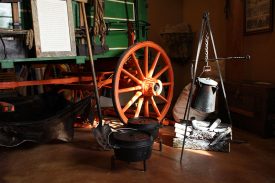
Chuckwagon Coffee Tipper over the campfire
When I look at a chuckwagon, I see much more than a range kitchen. Sure the kitchen was there for all the meals, coffee and biscuits for breakfast, beans, biscuits, meat, cobbler and coffee for supper; when the chuckwagon was set up there was always a pot of strong coffee brewing. But the chuckwagon was so much more to the cowhands far from home. While the cowhands were responsible for moving the herd, “Cookie” and his chuckwagon were responsible for moving the cowhands. The trail boss was officially in charge but it was “Cookie” who was always respected, never talked back to and issued most of the orders. After all, he not only fed you but also mended your clothes, had the medical supplies, moved your bedroll and belongings to the next camp, provided the entertainment, provided a place to wash up and shave and, most importantly, always had that pot of coffee going to rinse the trail dust from your throat. On a special occasion, “Cookie” might even break out a jug for a little nip of whiskey. Yea, you never wanted to be on the wrong side of Ol’ Cookie!
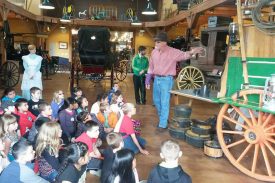
A field trip lesson about life on the range
The chuckwagon history is interesting. At the end of the civil war, lots of people were moving West and the market for beef expanded greatly. Cattleman, recognizing the need to move large herds without the help of railroads, developed the “trail drive” concept. Moving 1200 to 2000 head of cattle with 10 to 12 cowhands was not easy. Out on the trails for months at a time, these young men endured many hardships but it was “Cookie” and the chuckwagon at the end of the day who supplied the needed comfort. The chuckwagon was the gathering place, and sitting around the campfire, eating a meal, sipping some coffee, the cowhand was home.
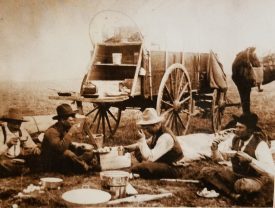 Credit for the chuckwagon goes to Charles Goodnight, a Texas rancher also known as the “father of the panhandle,” who invented it in 1866. Chuckwagons were built on numerous wagon running gears: ours is an 1890s chuckwagon built on a Spingfield Wagon Company gear. Springfield Wagons were known for their quality and durability, were marketed as “The Old Reliable” wagon, and were built from 1873 to 1951. This chuckwagon was used by its previous owners at chuckwagon food competitions throughout the Southwest and has won awards for its authenticity.
Credit for the chuckwagon goes to Charles Goodnight, a Texas rancher also known as the “father of the panhandle,” who invented it in 1866. Chuckwagons were built on numerous wagon running gears: ours is an 1890s chuckwagon built on a Spingfield Wagon Company gear. Springfield Wagons were known for their quality and durability, were marketed as “The Old Reliable” wagon, and were built from 1873 to 1951. This chuckwagon was used by its previous owners at chuckwagon food competitions throughout the Southwest and has won awards for its authenticity.
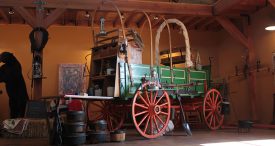 If you haven’t seen her, come on in for a visit… our chuckwagon is a real beauty!
If you haven’t seen her, come on in for a visit… our chuckwagon is a real beauty!
 Does anyone remember the old redwood water tower out on the South Fork of the Willapa River? We don’t have the tower itself, but we do have two beautiful Northwest Carriage Museum signs made from the original water tower redwood hanging above our front doors. These incredible pieces of artwork were designed and created by our good friend and wood carver, Jeffro Uitto, out in Tokeland. Jeffro is a woodworking extraordinaire and a man of many talents, you should see the magic he works with driftwood! His work is known throughout the world. Come take a look!
Does anyone remember the old redwood water tower out on the South Fork of the Willapa River? We don’t have the tower itself, but we do have two beautiful Northwest Carriage Museum signs made from the original water tower redwood hanging above our front doors. These incredible pieces of artwork were designed and created by our good friend and wood carver, Jeffro Uitto, out in Tokeland. Jeffro is a woodworking extraordinaire and a man of many talents, you should see the magic he works with driftwood! His work is known throughout the world. Come take a look!






